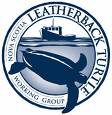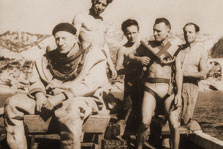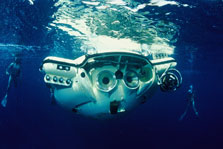
|
||
|
NEWSLETTER Issue N.2 - September 2007 |
||
![]() SELF-CONTAINED UNDERWATER BREATHING APPARATUS
SELF-CONTAINED UNDERWATER BREATHING APPARATUS
In Captain Cousteau's films, divers in silvery suits glide silently amid the marine life. Scuba frees them from the surface.
 The story of the Aqua-Lung goes back to World War II. In June, 1943, on a small beach of the Riviera, Jacques-Yves Cousteau, wearing rubber fins, should- ered the new completely autonomous diving gear.
The story of the Aqua-Lung goes back to World War II. In June, 1943, on a small beach of the Riviera, Jacques-Yves Cousteau, wearing rubber fins, should- ered the new completely autonomous diving gear.
It was inspired by the discoveries that preceded it, particularly that of Captain Yves Le Prieur, pioneer of autonomous diving who, in 1925, perfected an open-circuit, compressed-air device. There was one problem: the continuous flow of air limited how long the device could be used.
The solution was born in Paris. During the war, the Germans requisitioned automobile gas. Engineer Emile Gagnan invented a demand regulator that would feed cooking gas to a car's carburetor in the exact amount the jet needed. Cousteau modified the regulator, adapted it and made it the crowning piece of his Self-Contained Underwater Breathing Apparatus (SCUBA), the Aqua-Lung.
In 1966, Cousteau brought together his best divers, engineers and designers to provide Calypso with sophisticated equipment they called streamlined scuba. This new equipment reduced fatigue and consequently air consumption, allowing the divers to move about more quickly and for a longer time. The membrane of the regulator was positioned on the chest, closest to the center of the volume of air in the lungs.
![]() Read more about SCUBA
Read more about SCUBA
![]() DIVING SAUCER
DIVING SAUCER
Denise was her original name, and she was the first underwater vehicle designed expressly for scientific exploration.
 Developed by Jacques-Yves Cousteau and engineer Jean Mollard at the French Center for Undersea Research, the vehicle was dubbed the SP-350 or, less formally, "diving saucer", because of its resemblance to the flying saucers of science fiction.
Developed by Jacques-Yves Cousteau and engineer Jean Mollard at the French Center for Undersea Research, the vehicle was dubbed the SP-350 or, less formally, "diving saucer", because of its resemblance to the flying saucers of science fiction.
From 1959 on, the mini-submersible sailed the depths to explore unknown parts of the ocean. On board Calypso, a crane lowered the saucer into the water or lifted her up to the rear deck of the ship. With a diameter of 2.85 meters and a weight of 3.5 tons, she carries a crew of two in her steel cabin.
She can work stay as far as 350 meters down, for four or five hours.
The saucer moves just as a squid does, with an ingenious but simple jet propulsion system: water is drawn in from the outside and squirted back out through two tubes. With these jets, the saucer can move along underwater at a speed of 2 knots, or about 3.7 km/h. The two people inside are stretched out on mattresses, watching their surroundings through tilted portholes that let them come within a few centimeters of their subject.
The deeper the submersible goes, the darker the water, so three movable lights illuminate the "world without sun "at different angles. They can even light small objects up to 10 meters away and so reveal creatures that people have never before observed.
Onboard equipment includes two cameras, a radio and a tape recorder. The saucer is also furnished with a sampling arm, controlled from inside the cabin. Looking like a space ship, the diving saucer is perfectly suited to the environment in which it must work.
After tests, Denise became a permanent part of Calypso's armory and, today, it has more than 1,500 dives to its credit. Denise is the oldest sibling of scientific submersibles and opened a new era of underwater research.
In 1965, technology had evolved enough to allow for the construction of two new, more advanced one-man diving saucers. These little twins were baptized Sea Fleas and can descend to 500 meters.
![]() Read more about the "diving saucer"
Read more about the "diving saucer"
![]() PADI Open Water
PADI Open Water
 The PADI Open Water Diver course really does open the door to a whole world of adventure, from reef dives and
liveaboard dive cruises, to the exploration of ship- wrecks dives and seeing dolphins up close. The choices are endless and just waiting for you to explore.
The PADI Open Water Diver course really does open the door to a whole world of adventure, from reef dives and
liveaboard dive cruises, to the exploration of ship- wrecks dives and seeing dolphins up close. The choices are endless and just waiting for you to explore.
![]() Book online now.
Book online now.
![]() TDI Adv. Trimix
TDI Adv. Trimix
The TDI Advanced Trimix Course provides the training required to competently and safely utilize breathing gases containing helium for dives that require staged decom- pression, utilizing Nitrox and / or oxygen mixtures during decompression to a maximum depth of one hundred (100) msw / three hundred and thirty (330) fsw. The objective of this course is to train divers in the benefits, hazards and proper procedures of utilizing custom oxygen / helium / nitrogen mixtures as breath- ing gases.
![]() Book online now.
Book online now.


